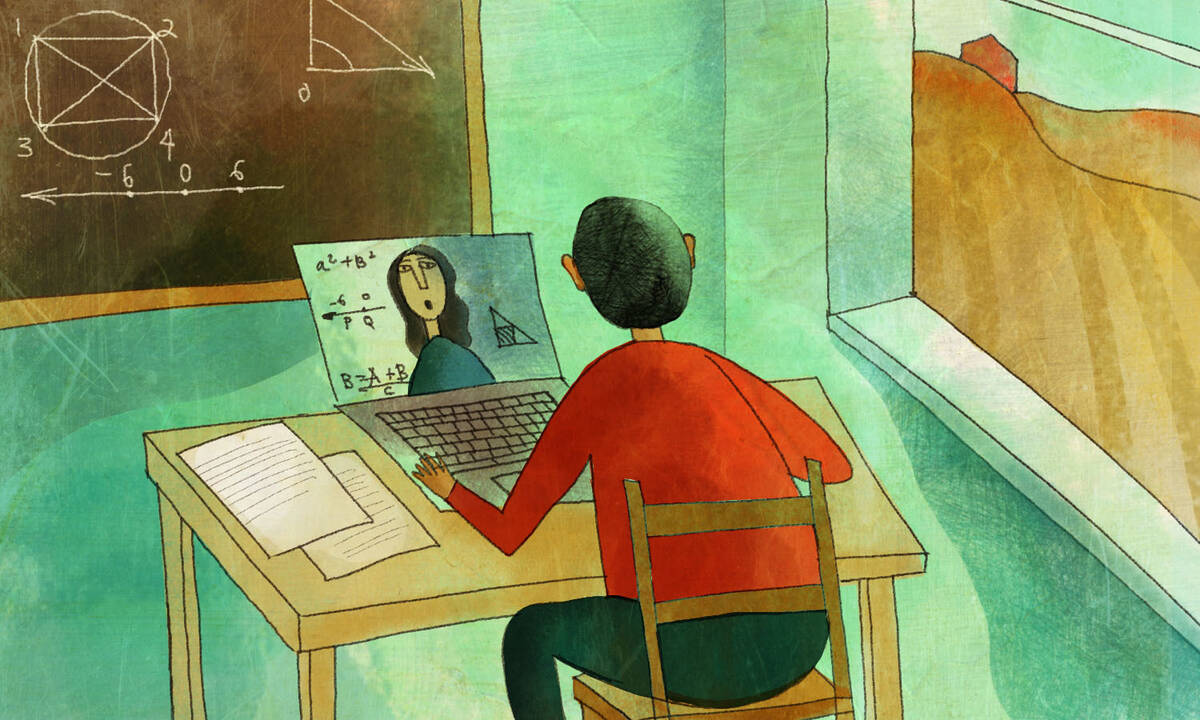Social Impact Policy Mar 1, 2021
There’s an Education Gap Between Rural and Urban Communities. Can Technology Bridge It?
Researchers identified a program that helps rural students learn—and improves their incomes later in life.

Yevgenia Nayberg
Where a child is born has enormous influence over their educational future.
Even within nations, there tends to be a yawning gap between urban and rural education outcomes. For instance, according to one 2015 standardized assessment, 15-year-olds studying in urban schools in 37 countries outperformed rural students by roughly the equivalent of one full year of schooling, even after controlling for students’ socioeconomic backgrounds.
Many of the solutions intended to narrow this urban–rural gap rely on technology—with a particular focus on tech tools that can help connect far-flung students to quality educators. But are these technologies really up to the challenge?
Most previous research on this question has focused on short-term outcomes, like the immediate effects on students’ test scores, notes Nicola Bianchi, assistant professor of strategy at the Kellogg School.
In a new study, however, Bianchi and coauthors Yi Lu, at Tsinghua University in Beijing, and Hong Song, at Fudan University in Shanghai, consider much-longer-term impacts: how much school rural students completed and what they went on to earn once they joined the workforce.
The researchers focused on China, a country with a particularly pronounced chasm between the quality of urban and rural education systems. In 2004, as part of an effort to address the disparity, the Chinese government started a program to connect over 100 million rural students with highly qualified urban teachers via satellite. Because of the large number of students involved, the Chinese program is likely the world’s largest-ever education-technology intervention, the researchers note.
Then, using data from a massive survey conducted a decade later, the team was able to analyze the long-term effects of this reform on students’ educational and career trajectories.
They found that rural Chinese students who had access to classes delivered by top teachers appeared to benefit in multiple ways that persisted over time. Specifically, those who had been exposed in middle school to lectures recorded by high-quality urban teachers ultimately completed more education than their peers and earned significantly more once they started working.
“Technology can be a fantastic way to bring high-quality education by some of the best teachers in the country to rural areas without trying to convince teachers to relocate,” Bianchi says. “In other words, when it comes to increasing the quality of education in these underserved areas, technology can be the channel through which we achieve that.”
Tracking Students Touched by an Educational Reform
The average rural student in China has long lacked access to the same quality of education as his or her urban peers. In 2000, a few years before China’s ambitious rural education project began, only 14 percent of rural middle-school teachers held a bachelor’s degree—less than half of the percentage among their urban counterparts. Rural schools also had larger class sizes than urban ones and often lacked necessary teaching materials.
This appeared to affect students’ trajectory after middle school. Only 7 percent of rural Chinese middle-school students went on to enroll in high school; among urban students, high-school enrollment was over nine times higher.
“The exposure to the education technology allowed [rural students] to escape the most common job in very rural parts of China, which is working in agriculture.”
— Nicola Bianchi
To lessen this divide, the Chinese Ministry of Education in 2004 embarked on a four-year project to install satellite dishes, computer rooms, and other multimedia equipment in the country’s rural schools. It also sought the highest-credentialed teachers in the country to record lectures that rural students could access via the internet and DVDs. (Most of those teachers came from selective urban elementary and middle schools.)
The researchers estimate that the average rural student watched roughly seven 45-minute lectures per week. Importantly, the students watched the lectures not from their own homes, but in school classrooms, under the supervision of local teachers.
To analyze the long-term impacts of these technological interventions, the researchers turned to the 2014 China Family Panel Studies, a representative survey of Chinese communities, families, and individuals conducted by Peking University. Of particular interest to Bianchi and his coauthors were respondents’ age, educational attainment, and earnings. Also, crucially, the survey asked respondents where they lived at age 12, which allowed the researchers to ascertain if their middle school benefitted from the new educational technology during their time there.
Shifting Educational and Employment Futures
The researchers’ analysis revealed that the Chinese government’s ambitious program did discernibly benefit rural students—not only academically, but in the job market as well.
Rural students with access to the government’s computer-assisted learning program completed 0.85 years of additional schooling compared with those without access. And remarkably, nearly a decade after their time in middle school, these rural students also earned 59 percent more than peers in the same county not touched by the reform.
“What was interesting was that it was not just an earnings increase, but a difference in type of occupations,” Bianchi says. “The exposure to the education technology allowed them to escape the most common job in very rural parts of China, which is working in agriculture. They were moving away from these jobs and towards jobs that were more focused on cognitive skills.”
Bianchi and his coauthors conclude that exposure to the program accounted for a 21 percent reduction in the preexisting urban–rural education gap and a 78 percent reduction in the earnings gap.
The program also furnished rural schools with the ability to introduce computer-science classes and the means for rural teachers to incorporate computers into their own lectures. Yet the researchers point to the recorded lectures by the highly credentialed teachers as the standout star in terms of their impact on the students. The other technologies, they write, “are not corroborated by data and anecdotal evidence” as discernibly benefiting students.
Narrowing a Persistent Regional Divide
So the technology initiative had a significant, positive impact on the students. Does this translate to benefits for students around the globe who are using technology to learn remotely during COVID-19? Bianchi says it likely doesn’t.
It’s important to remember, he says, that the Chinese reform placed students in a learning context quite different from the living rooms and kitchen tables that most virtual students are dealing with today.
“When we generally talk about remote learning, we think about students by themselves at home, sometimes without any type of supervision, taking or following a class,” he says. “The Chinese example was very different because the students were in class and they were under the direct supervision of the local teachers.”
Bianchi notes that he expects a wide variety of sectors to embrace a remote format even after the pandemic is over—but he doesn’t expect education to be one of them. There are simply too many clear benefits of in-person learning.
“But that doesn’t mean technology can’t help rural areas get access to something that they wouldn’t have, even in person,” he says.



